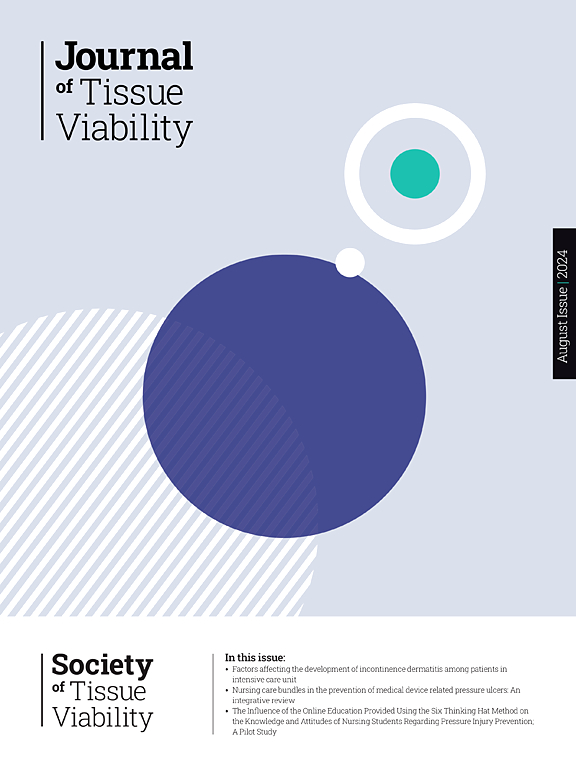新生儿病房中依赖相关皮肤病变的患病率和危险因素:一项跨西班牙医院的多中心研究
IF 2.4
3区 医学
Q2 DERMATOLOGY
引用次数: 0
摘要
目的本研究旨在获得西班牙医院新生儿病房中依赖相关性皮肤病变(DRSLs)的最新流行病学指标,并分析与DRSLs发展相关的预防干预措施和危险因素。材料和方法在西班牙12家设有新生儿病房的医院进行了一项多中心、观察性、横断面流行病学研究,分三个数据收集阶段,包括398名住院新生儿。数据收集基于直接观察、临床记录回顾和护理人员访谈。采用新生儿皮肤风险评估量表(e-NSRAS)评估DRSL风险。人口统计变量、危险因素和预防措施也进行了分析。结果drsl患病率为29.4%。湿度相关病变(18.6%)最为常见,尤其是在中间护理阶段,其次是压力损伤(13.07%),在重症监护中更为常见,摩擦相关病变(3.02%)。无创机械通气和导尿与DRSL的发生显著相关。此外,34%的新生儿被归类为有压力损伤风险。在住院新生儿中观察到高DRSL患病率,超过其他国家和国际研究报告的发生率。e- nsra似乎不适合评估所有的DRSL类型。使用多种医疗器械与较高的DRSL发生率相关,而且预防措施往往实施得较晚或不充分。研究的局限性包括典型的横断面研究,如代表性、混杂因素和样本量。结论drsls是西班牙新生儿普遍存在的问题。制定和实施有针对性的预防措施,以及调整评估工具,对于提高新生儿护理质量至关重要。本文章由计算机程序翻译,如有差异,请以英文原文为准。
Prevalence and risk factors of dependence-related skin lesions in neonatal units: A multicentre study across Spanish hospitals
Aim
This study aimed to obtain updated epidemiological indicators of dependence-related skin lesions (DRSLs) in neonatal units of Spanish hospitals and to analyze preventive interventions and risk factors associated with DRSL development.
Materials and methods
A multicentre, observational, cross-sectional prevalence study was conducted across three data collection phases in 12 Spanish hospitals with neonatal units, and included 398 hospitalised neonates. Data collection was based on direct observation, clinical record review, and caregiver interviews. The Neonatal Skin Risk Assessment Scale (e-NSRAS) was used to assess DRSL risk. Demographic variables, risk factors, and preventive measures were also analyzed.
Results
DRSL prevalence was 29.4 %. Moisture-related lesions (18.6 %) were the most common, especially in intermediate care, followed by pressure injuries (13.07 %), more prevalent in intensive care, and friction-related lesions (3.02 %). Non-invasive mechanical ventilation and urinary catheterisation were significantly associated with DRSL occurrence. Additionally, 34 % of neonates were classified as at risk of pressure injuries.
Discussion
A high DRSL prevalence was observed among hospitalised neonates, exceeding rates reported in other national and international studies. The e-NSRAS appears unsuitable for assessing all DRSL types. The use of multiple medical devices was associated with higher DRSL rates, and preventive measures were often applied late or inadequately. Study limitations include those typical of cross-sectional studies, such as representativeness, confounding factors, and sample size.
Conclusion
DRSLs are a prevalent issue in Spanish neonatal units. The development and implementation of targeted preventive measures, along with the adaptation of assessment tools, are critical for enhancing the quality of neonatal care.
求助全文
通过发布文献求助,成功后即可免费获取论文全文。
去求助
来源期刊

Journal of tissue viability
DERMATOLOGY-NURSING
CiteScore
3.80
自引率
16.00%
发文量
110
审稿时长
>12 weeks
期刊介绍:
The Journal of Tissue Viability is the official publication of the Tissue Viability Society and is a quarterly journal concerned with all aspects of the occurrence and treatment of wounds, ulcers and pressure sores including patient care, pain, nutrition, wound healing, research, prevention, mobility, social problems and management.
The Journal particularly encourages papers covering skin and skin wounds but will consider articles that discuss injury in any tissue. Articles that stress the multi-professional nature of tissue viability are especially welcome. We seek to encourage new authors as well as well-established contributors to the field - one aim of the journal is to enable all participants in tissue viability to share information with colleagues.
 求助内容:
求助内容: 应助结果提醒方式:
应助结果提醒方式:


